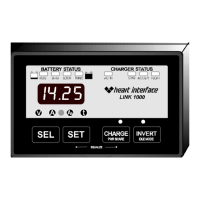02/11/98
37
READ BEFORE WIRING !!!!!
Before wiring the
Link 1000
, install the shunt as indicated.
All wiring should be done before installing the meter power fuse.
GENERAL NOTES
1) Wiring to the
Link 1000
should be #16 or #18 AWG. (Larger is OK, but not necessary.)
Wiring should be in accordance with the NEC, ABYC, or other applicable standards.
2) The Shunt Sense Leads should be a twisted pair. Leads up to 250 feet long may be used
if they are not run close to other noise producing conductors and #16 AWG or larger twisted
pair wire is used. Offset error should be less than 0.2 Amps.
For the easiest installation you may wish to purchase our four twisted pair cable with
the same color code as enclosed wiring diagram. This cable may be run between the meter
and the batteries to supply all needed signals. This cable is available from your dealer or
from Heart Interface in various convenient lengths.
Note: You may make your own twisted pair wire by chucking up two wires in an electric
drill and twisting them by running the drill motor until there is a twist or two every inch.
A wrap of tape every 16" will keep the wires together and make them easier to pull through
holes and raceways.
3) Caution! If your starter draws more than 500 amps see #5 below.
4) Battery current is sensed with a shunt which is a very precise, small resistance. It is
inserted in series (in line) in the negative wire of the battery (battery bank) you wish to
measure. The current is measured by sensing the voltage drop across this resistance.
The
Link 1000
uses a 50 mV @ 500 Amp shunt. When 500 Amps flows through the shunt,
there is a 50 mV drop across it. Thus 10 Amps equals 1 mV or 1 Amp equals 0.1mV The
meter displays this small voltage as Amps. If you wish to check this you will need a
very
accurate digital meter (Fluke 87 in 4 1/2 digit mode or better) if the current is below 30
Amps (3.0mV). Above 50 Amps most digital meters can be used for testing.
5) Big Engine Note: If your starter current exceeds 500 Amps for more than 10 seconds,
as may be the case with gas engines of more than 350 cubic inches or diesel engines of more
than 100 horsepower, you'll need to either use a heavy duty shunt or connect the starter
negative directly to the battery side (BSHB) of the shunt so that starter current does not
flow through it. The problem with wiring so that starter current doesn't go through the
shunt is that if the alternator is of the grounded case type, its charging current will not
be flowing through the shunt either. The alternator ground must be isolated from the engine
and run to the load side (BSHG) of the battery shunt to be able to measure the current
going into the battery from the alternator. Isolated negative output alternators are
CAUTION!!!!
The output voltage of the shunt is very small. It is critical that all of the
connections for the shunt sense leads have the highest possible integrity. Every
effort must be made to prevent corrosion that might affect the sense leads.

